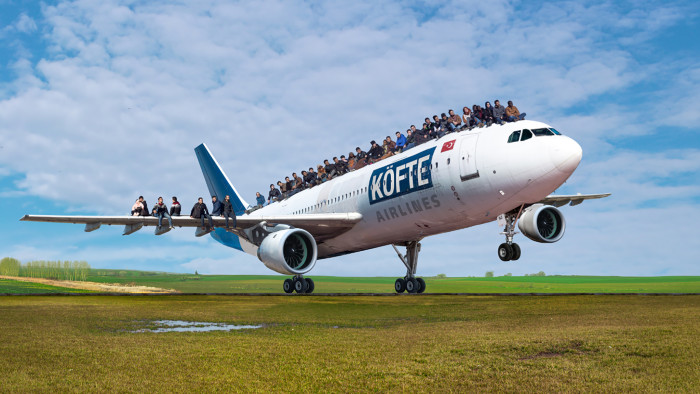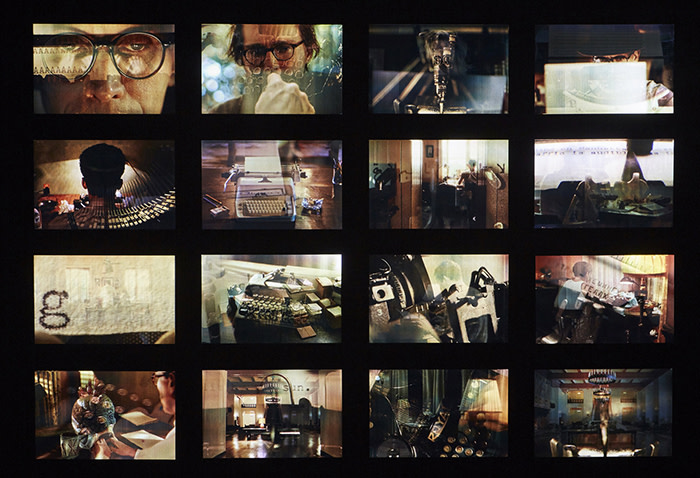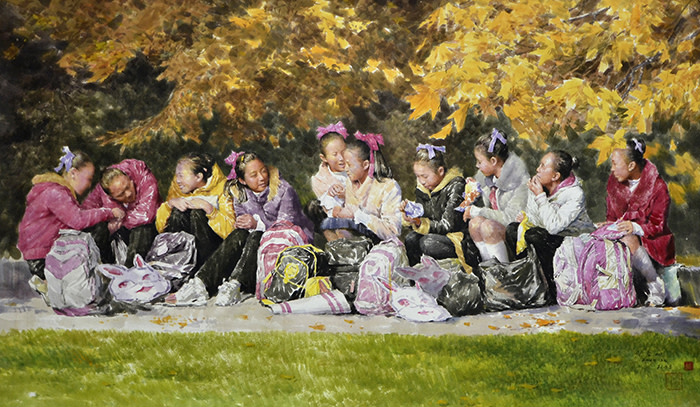Film and photography dominate Gwangju Biennale

Simply sign up to the Life & Arts myFT Digest -- delivered directly to your inbox.
A plump, bespectacled toad gazes lovingly at a boy. A girl plays chess in the embrace of a pointy-shelled snail. A spider shelters an injured boy, its long, spindly legs providing anchors for his drips, as if they were hospital machinery. In 20 beautiful monochrome drawings, splashed judiciously with colour, So Yun Kyoung’s “Combi” depicts a world in which young survivors of a “great war” depend on large, emotionally intelligent insects, rodents and amphibians for their survival.
So’s surreal, Alice in Wonderland-like work is but one instance in a seemingly infinite variety of ways to address the Gwangju Biennale’s title: Imagined Borders. To reach her appealing utopia you must pass through a dark tunnel (Park Sang Hwa’s forest video installation). Go back the other way, however, and the visions of her fellow Koreans are not so optimistic.
Mun Seon hee’s “border” in “Trace”, for example, separates the heard from the unheard in stories of Korea’s past. She is one of a number of artists trawling survivors’ memories of the Gwangju Uprising of May 1980, which was savagely suppressed and resulted in more than 600 civilians losing their lives. Yeo Sang Hee, meanwhile, highlights a real border via a flickeringly lit, barbed wire-bound cell evoking prisoner-of-war camps from the still unresolved war between north and south.
Two-thirds of the 163 artists participating in the Gwangju Biennale’s 12th edition come from Asia, and Koreans figure strongly among them. Where the Biennale moves outside the region, it is mostly to showcase the work of artists from non-first world countries, including Cuba, Brazil and Lebanon. While past editions have been overseen by a single international star — Harald Szeemann, Okwui Enwezor and Massimiliano Gioni among them — this one comprises seven exhibitions, assembled by no fewer than 11 curators. The truly remarkable thing about it is its coherence: the notion of a border may be used in many different ways, but both across exhibitions and within each one, the idea is never far away.
The show opens with Imagined Nations/Modern Utopias, a highly original exhibition curated by Tate Modern’s Clara Kim that reflects on postwar modernist architectural projects in Asia, Latin America and the Middle East. It was an era of nation-building, when the likes of Le Corbusier and Oscar Niemeyer had carte blanche to create whole new cities, but, as Kim notes, for the generations born in the 1960s through to the 1980s, the modernist project was often “anything but heroic”.
Kim’s exhibition is about people and architecture, rather than “an architecture exhibition”, she insists — though arguably all good architecture exhibitions should be, at least in part, about people. Lais Myrrha’s giant, white wing-like sculpture makes for a dramatic opening to the show. A life-sized reproduction of a column from Niemeyer’s ambitious presidential palace in Brasília, it appears to float. Walk round the back, however, and you find it is propped up by a classical column from a landmark of 18th-century colonial architecture outside Rio. For Myrrha, Brazilian modernism was rooted in colonialism.

For the most part this is a quiet, thought-provoking exhibition where it pays to read the well-written captions. Damián Ortega’s “wearable” leather sculptures, hanging limply from meat hooks, are visually arresting, but it helps to know that they are cut-outs of the floor plans of modernist mansions built in Mexico’s wealthy El Pedregal neighbourhood, many of which have long since been demolished, or reclaimed by the vegetation.
Film and photography dominate this show. It is worth taking time over works such as Amie Siegel’s lyrically shot video, which explores the global trade in modernist furniture by working backwards from auctions and collectors, through restorers, to the none too well cared for pieces by Le Corbusier that remain in their original home in Chandigarh, India.
Gridthiya Gaweewong’s show Facing Phantom Borders harks back to the first Gwangju Biennale in 1995, seeking out, as she put it, the stories of “people from the margins”. In that show, titled Beyond Borders, artists were responding to the mass mobility unleashed by globalisation and the mood was, above all, hopeful. Today, the agony of an asylum seeker glimpsed in the shadows in Agnieszka Kalinowska’s film Draughty House (2009) who cries, “We can’t live in Afghanistan — that is why we came here, to be alive” is more appropriate. Or the words springing from blue water in a Sawangwongse Yawnghwe painting: “Which way to land?”
A theme of south-east Asia as contested ground during the cold war emerges in this section too, most notably in Ho Tzu Nyen’s riveting if ultimately impenetrable espionage thriller “The Nameless & the Name”, which centres on both the mysterious writer Gene Z Hanrahan and Lai Teck, an alias of the secretary-general of the Malayan Communist party during the 1940s, who was exposed as a triple agent. The film montages Hollywood clips of authors at a typewriter and darkly lit east Asian dramas; the style is very much Christian Marclay.

Borders here may be conceptual or spiritual as well as physical. In new filmed interviews by Kader Attia, people talk of healing psychological wounds in the wake of the Gwangju Uprising, the monitors surrounded by a disturbing set of prosthetic limbs seated on chairs from the former Armed Forces’ Gwangju Hospital. Attia’s videos have an echo in the form of his patched-up wooden figures in the dusty cells of what was the psychiatric department of the hospital, now a crumbling edifice 15 minutes by taxi from the main hall. Elsewhere in the hospital, experimental film-maker Apichatpong Weerasethakul’s site-specific installation evokes flickering memories of a scarred city, while Mike Nelson has hung mirrors plastered with instructions on haircuts and washing hands in the nearby ruined chapel.
While artists such as Yeo Sang Hee simply allude to the border between South Korea and its northern neighbour, one exhibition steps firmly over that line. BG Muhn, a Korean artist and professor of painting and drawing at Washington DC’s Georgetown University, has assembled an exhibition of rarely seen North Korean art. Government officials insisted the show not be too sympathetic, so curating the project was “very stressful”, Muhn says. “I had to drink a lot of soju [Korean vodka]!”
The work on show is socialist realist — but not socialist realist as we know it. Rather than depict smiling heroic workers in oil paint, as was the case in 1930s Russia or Mao’s China, these paintings are what the North Koreans call chosonhwa, traditional ink-wash painting on rice paper. It takes great skill: one misplaced drop of ink and you have to start again. The other surprise is the range of subjects. Beyond the brave workers, there are delicate literati paintings, landscapes and scenes of everyday life. Choe Yu Song’s “On the Way Home” depicts schoolkids picnicking under autumn trees; Kim In Sok’s “Rain Shower at the Bus Stop” is impressively cinematic.
Muhn speaks of the tension between propaganda and individual expression in these paintings and nowhere is that more evident than in Kim Song Min’s “Mom, Your Youngest Son is Here”, in which an old woman runs to embrace her middle-aged child. Like the best Hollywood melodrama, it brings a lump to your throat: I can’t be alone in wishing it might one day be a metaphor for rapprochement between north and south.
To November 11, gwangjubiennale.org
Follow @FTLifeArts on Twitter to find out about our latest stories first. Subscribe to FT Life on YouTube for the latest FT Weekend videos
Comments